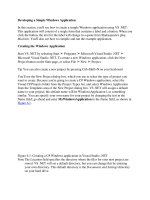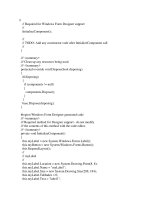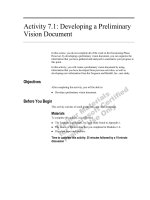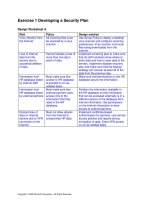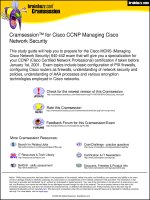Developing a Security Policy
Bạn đang xem bản rút gọn của tài liệu. Xem và tải ngay bản đầy đủ của tài liệu tại đây (55.46 KB, 14 trang )
Sun Microsystems, Inc.
901 San Antonio Road
Palo Alto, CA 94303 USA
650 960-1300 fax 650 969-9131
/>Developing a
Security Policy
By Joel Weise - SunPS
SM
Global Security Practice and
Charles R. Martin - SunPS Java™ Centers
Sun BluePrints™ OnLine - December 2001
Part No.: 816-1953-10
Revision 1.0, 11/28/01
Edition: December 2001
Please
Recycle
Copyright 2001 Sun Microsystems, Inc. 901 San Antonio Road, Palo Alto, California 94303 U.S.A. All rights reserved.
This product or document is protected by copyright and distributed under licenses restrictingits use, copying, distribution, and decompilation.
No part of this product or document may be reproduced in any form by any means without prior written authorization of Sun and its licensors,
if any. Third-party software, including font technology, is copyrighted and licensed from Sun suppliers.
Parts of the product may be derived from Berkeley BSD systems, licensed from the University of California. UNIX is a registered trademark in
the U.S. and other countries, exclusively licensed through X/Open Company, Ltd.
Sun, Sun Microsystems, the Sun logo, Sun BluePrints, SunPS, Java, and Solaris are trademarks or registered trademarks of Sun Microsystems,
Inc. in the United States and other countries.
The OPEN LOOK and Sun™ Graphical User Interface was developed by Sun Microsystems, Inc. for its users and licensees. Sun acknowledges
the pioneering efforts of Xerox in researching and developing the concept of visual or graphical user interfaces for the computer industry. Sun
holds a non-exclusive license from Xerox to the Xerox Graphical User Interface, which license also covers Sun’s licensees who implement OPEN
LOOK GUIs and otherwise comply with Sun’s written license agreements.
RESTRICTED RIGHTS: Use, duplication, or disclosure by the U.S. Government is subject to restrictions of FAR 52.227-14(g)(2)(6/87) and
FAR 52.227-19(6/87), or DFAR 252.227-7015(b)(6/95) and DFAR 227.7202-3(a).
DOCUMENTATION IS PROVIDED “AS IS” AND ALL EXPRESS OR IMPLIED CONDITIONS, REPRESENTATIONS AND WARRANTIES,
INCLUDING ANY IMPLIED WARRANTY OF MERCHANTABILITY, FITNESS FOR A PARTICULAR PURPOSE OR NON-
INFRINGEMENT, ARE DISCLAIMED, EXCEPT TO THE EXTENT THAT SUCH DISCLAIMERS ARE HELD TO BE LEGALLY INVALID.
Copyright 2001 Sun Microsystems, Inc., 901 San Antonio Road, Palo Alto, Californie 94303 Etats-Unis. Tous droits réservés.
Ce produit ou document est protégé par un copyright et distribué avec des licences qui en restreignent l’utilisation, la copie, la distribution, et la
décompilation. Aucune partie de ce produit ou document ne peut être reproduite sous aucune forme, par quelque moyen que ce soit, sans
l’autorisation préalable et écrite de Sun et de ses bailleurs de licence, s’il y en a. Le logiciel détenu par des tiers, et qui comprend la technologie
relative aux polices de caractères, est protégé par un copyright et licencié par des fournisseurs de Sun.
Des parties de ce produit pourront être dérivées des systèmes Berkeley BSD licenciés par l’Université de Californie. UNIX est une marque
déposée aux Etats-Unis et dans d’autres pays et licenciée exclusivement par X/Open Company, Ltd.
Sun, Sun Microsystems, le logo Sun, Sun BluePrints, SunPS, Java, et Solaris sont des marques de fabrique ou des marques déposées, ou marques
de service, de Sun Microsystems, Inc. aux Etats-Unis et dans d’autres pays.
L’interface d’utilisation graphique OPEN LOOK et Sun™ a été développée par Sun Microsystems, Inc. pour ses utilisateurs et licenciés. Sun
reconnaît les efforts de pionniers de Xerox pour la recherche et le développement du concept des interfaces d’utilisation visuelle ou graphique
pour l’industrie de l’informatique. Sun détient une licence non exclusive de Xerox sur l’interface d’utilisation graphique Xerox, cette licence
couvrant également les licenciés de Sun qui mettent en place l’interface d’utilisation graphique OPEN LOOK et qui en outre se conforment aux
licences écrites de Sun.
CETTE PUBLICATION EST FOURNIE "EN L’ETAT" ET AUCUNE GARANTIE, EXPRESSE OU IMPLICITE, N’EST ACCORDEE, Y COMPRIS
DES GARANTIES CONCERNANT LA VALEUR MARCHANDE, L’APTITUDE DE LA PUBLICATION A REPONDRE A UNE UTILISATION
PARTICULIERE, OU LE FAIT QU’ELLE NE SOIT PAS CONTREFAISANTE DE PRODUIT DE TIERS. CE DENI DE GARANTIE NE
S’APPLIQUERAIT PAS, DANS LA MESURE OU IL SERAIT TENU JURIDIQUEMENT NUL ET NON AVENU.
1
Developing a Security Policy
A security policy is the essential basis on which an effective and comprehensive
security program can be developed. This critical component of the overall security
architecture, however, is often overlooked. A security policy is the primary way in
which management’s expectations for security are translated into specific,
measurable, and testable goals and objectives. It is crucial to take a top down
approach based on a well-stated policy in order to develop an effective security
architecture. Conversely, if there isn’t a security policy defining and communicating
those decisions, then they will be made by the individuals building, installing, and
maintaining computer systems; and this will result in a disparate and less than
optimal security architecture being implemented.
This article discusses the importance of security policies for organizations that plan
to use electronic commerce on the Internet; for government organizations that want
to automate forms processing; and for any entity that may have external exposure of
data processing environments. These organizations need some form of security
architecture. This article also describes the basic steps through which security
policies are developed and includes a set of recommended policy components.
In addition, this article is accompanied by a Data Security Policy - Structure and
Guidelines template that was built on the recommendations made in this article. The
template provides commentary; specific recommendations on all of the security
topics chosen for the policy; and a detailed list of security policy principles. The
template is available from:
/>The objectives of this article are to:
■
Provide an overview of the necessity and criticality of security policies.
■
Recommend a set of security policy principles that capture management’s
primary security objectives.
■
Describe the basic characteristics of security policies.
■
Describe a process for developing security policies.
2 Developing a Security Policy • December 2001
Security Principles
The definition of security principles is an important first step in security policy
development as they dictate the specific type and nature of security policies most
applicable to one’s environment. Security principles are used to define a foundation
upon which security policies can be further defined. Organizations should evaluate
and review these security principles before and after the development and
elaboration of security policies. This will ensure that management’s expectations for
security and fundamental business requirements are satisfied during the
development and management of the security policies.
The security policies developed must establish a consistent notion of what is and
what is not permitted with respect to control of access to your data and processing
resources. They must respond to the business, technical, legal, and regulatory
environment in which your organization operates.
The principles here are based upon the following goals:
■
Ensure the availability of data and processing resources.
■
Provide assurance for the confidentiality and integrity of customer data and allow
for the compartmentalization of risk for customers and your organization.
■
Ensure the integrity of data processing operations and protect them from
unauthorized use.
■
Ensure the confidentiality of the customer’s and your processed data, and prevent
unauthorized disclosure or use.
■
Ensure the integrity of the customer’s and your processed data, and prevent the
unauthorized and undetected modification, substitution, insertion, and deletion
of that data.
Security Policy Fundamentals
This section provides basic information on the purpose, goal, definition, and
implementation of a security policy. In addition, this section discusses the flexibility,
communication, and management of an established security policy.
Security Policy Fundamentals 3
Purposes of a Security Policy
The primary purpose of a security policy is to inform users, staff, and managers of
those essential requirements for protecting various assets including people,
hardware, and software resources, and data assets. The policy should specify the
mechanisms through which these requirements can be met.
Another purpose is to provide a baseline from which to acquire, configure, and audit
computer systems and networks for compliance with the policy. This also allows for
the subsequent development of operational procedures, the establishment of access
control rules and various application, system, network, and physical controls and
parameters.
Security Policy Goals
The goal of the security policy is to translate, clarify and communicate
management’s position on security as defined in high-level security principles. The
security policies act as a bridge between these management objectives and specific
security requirements.
Definition of a Security Policy
A security policy is a formal statement of the rules through which people are given
access to an organization’s technology, system and information assets. The security
policy defines what business and security goals and objectives management desires,
but not how these solutions are engineered and implemented.
A security policy should be economically feasible, understandable, realistic,
consistent, procedurally tolerable, and also provide reasonable protection relative to
the stated goals and objectives of management. Security policies define the overall
security and risk control objectives that an organization endorses. The characteristics
of good security policies are:
■
They must be implementable through system administration procedures,
publishing of acceptable use guidelines, or other appropriate methods.
■
They must be enforceable with security tools, where appropriate, and with
sanctions, where actual prevention is not technically feasible.
■
They must clearly define the areas of responsibility for the users, administrators,
and management.
■
They must be documented, distributed, and communicated.





